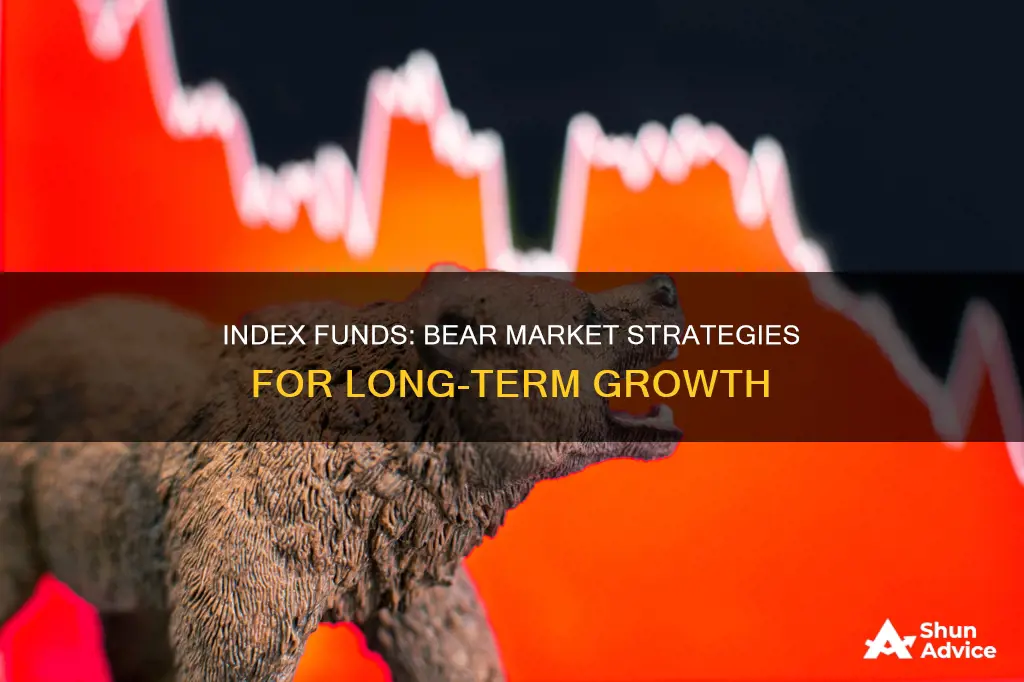
Bear markets can be scary, but they also present opportunities for investors. Index funds are a passive way to capitalise on bearish stock movements without needing to be a stock expert.
Index funds are a type of investment fund that holds a basket of stocks or other assets. They are designed to track the performance of a specific market index, such as the S&P 500 or Nasdaq. This means that when you invest in an index fund, you are effectively investing in all the stocks or assets within that index.
During a bear market, when stock prices are generally falling, investing in an index fund can be a way to diversify your portfolio and reduce risk. Here are some of the best bear market index funds to consider:
- Consumer Staples Select Sector SPDR Fund (XLP): This fund tracks the Consumer Staples Select Sector Index, which includes food and beverage, tobacco, and personal product companies. It has a 10-year average return of 9.86% and a low expense ratio of 0.13%.
- iShares Nasdaq Biotechnology ETF (IBB): This fund tracks the Nasdaq Biotechnology Index, which holds a variety of biotech firms. It delivered a 10-year average annual return of 13.77%.
- Vanguard S&P 500 ETF (VOO): This fund tracks the S&P 500 index, which includes the 500 largest public companies in the US, such as Microsoft, Amazon, and Facebook. It has a low expense ratio of 0.03%.
- Vanguard Information Technology Index ETF (VGT): This fund attempts to match the performance of the MSCI US Investable Market Information Technology 25/50 Index, which includes small, mid, and large-cap companies from the IT sector, such as Apple, Intel, and Nvidia. It posted a 10-year average annual return of 15.50%.
- ProShares S&P 500 Dividend Aristocrats ETF (NOBL): This fund tracks the S&P 500 Dividend Aristocrats Index, which includes companies that have consistently increased their dividend payouts for 25 years or longer. It has a dividend yield of 2.66% and has posted double-digit annual returns in most years since its inception in 2013.
- Fidelity 500 Index Fund (FXAIX): This fund is similar to the Vanguard S&P 500 ETF but is offered by Fidelity. It has a 10-year average annual return of 10.51% and a very low expense ratio of 0.01%.
- Utilities Select Sector SPDR Fund (XLU): This fund seeks to match the performance of the Utilities Select Sector Index, which includes top energy providers and utility companies. It has one of the best yields at 3.52% and a low expense ratio of 0.13%.
What You'll Learn

Invest in defensive sectors
Defensive sectors are a good investment during a bear market because they tend to outperform during such periods. These sectors include consumer staples, utilities, and healthcare.
Consumer staples are essential goods that people need regardless of the economic climate. Examples include food and beverages, tobacco, and personal products. During a bear market, investors tend to favour companies that have already shown resilience and are likely to continue doing so. The Consumer Staples Select Sector SPDR Fund (XLP) is a good example of a defensive fund in this sector, with a 10-year average return of 9.86% and a yield of 2.95%.
Utilities are another defensive sector as utility services are basic needs. The Utilities Select Sector SPDR Fund (XLU) is a good option for investors looking to own index funds in this sector. It has one of the best yields at 3.52% and includes top energy providers such as NextEra Energy and Dominion Energy.
Healthcare is also a defensive sector as people will always need medical care. The iShares Nasdaq Biotechnology ETF (IBB) is a solid index fund option in this sector, with a 10-year average annual return of 13.77%.
Defensive sectors are a good choice for investors during a bear market as they tend to be more stable and generate plenty of cash, supporting relatively high dividend yields.
Invest in Tesla: Top Mutual Funds to Consider
You may want to see also

Diversify your portfolio
Diversifying your portfolio is a crucial strategy for navigating bear markets. Here are some tips to help you diversify effectively:
- Defensive sectors: Focus on defensive stock sectors, such as consumer staples, utilities, and healthcare. These sectors tend to outperform during bear markets as they provide essential goods and services that remain in demand regardless of economic conditions. Examples include food, beverages, personal care items, and healthcare products.
- Dividend-paying stocks: Look for companies that pay higher-than-average dividends. Even if stock prices aren't increasing, investors still value the income generated by dividends.
- Bonds: Consider investing in high-quality, short-term bonds, as their prices often move in the opposite direction of stock prices. During uncertain economic times, bonds can provide a stable source of income.
- Index funds and ETFs: Invest in a variety of sectors through index funds or exchange-traded funds (ETFs). This will give you exposure to multiple companies within a sector, reducing the risk associated with individual stocks.
- Gold and precious metals: Precious metals, particularly gold, often outperform the market during bear markets. They are seen as a hedge against inflation and a safe haven in times of economic uncertainty.
- Low-volatility stocks: Seek out stocks with low volatility to limit downside risks during a bear market. You can find low-volatility ETFs that track indices composed of stocks with low realized volatility over a specific period.
- Energy and consumer discretionary: While defensive sectors are crucial, don't overlook sectors like energy and consumer discretionary, which can sometimes outperform during bear markets. For example, energy was the best-performing sector during the 2022 bear market.
- Healthcare: Healthcare stocks are another reliable sector during bear markets. Healthcare expenditures tend to rise steadily, regardless of economic conditions, as consumers have no choice but to pay for medical needs.
- Short-term US Treasury bonds: In a rising interest rate environment, short-term US Treasury bonds can offer relative stability. They are considered safer than longer-dated bonds as the risk of default is lower for shorter maturities.
- Investment-grade corporate bonds: Focus on high-quality investment-grade corporate bonds, which offer attractive income opportunities and relatively lower risks compared to longer-dated government bonds.
Remember, diversification is a key strategy to curb bear market risks and enhance long-term returns. By spreading your investments across various sectors and asset classes, you can reduce the impact of market volatility and improve your portfolio's resilience.
Unlocking Interval Fund Investment Opportunities: Exploring Strategies
You may want to see also

Dollar-cost averaging
Here's how it works: instead of investing a lump sum all at once, you invest smaller amounts at regular intervals, such as monthly or quarterly. This means that when stock prices are high, you buy fewer shares, and when prices are low, you buy more. This strategy implicitly follows the advice to "buy low, sell high".
For example, let's say you invest $100 in a stock when the price is $100 per share, giving you one share. The next month, the stock price drops by 50% to $50 per share. With dollar-cost averaging, your $100 investment now buys you two shares instead of one. This strategy keeps you invested and helps you take advantage of lower stock prices, potentially setting you up for long-term gains.
- It is most effective when the stock market is volatile and you are investing over a longer period.
- It is often used with retirement plans, such as 401(k) plans, where a set percentage of an employee's salary is contributed to the retirement plan after each paycheck.
- It is best used with index funds and ETFs (exchange-traded funds) rather than individual stocks, as a diversified investment will be less volatile.
- It may result in buying more shares at lower prices and fewer shares at higher prices, which can amplify returns over time.
- It helps investors avoid the risky and often unsuccessful endeavour of trying to time the market.
In summary, dollar-cost averaging is a powerful strategy that can be beneficial during a bear market. It helps investors stay invested, take advantage of lower stock prices, and reduce the emotional impact of market volatility.
A Guide to Investing in GMO Funds
You may want to see also

Focus on long-term goals
Bear markets can be scary, but they are a normal part of investing and tend to be relatively short-lived. If you're investing for the long term, it's important to keep your eye on the bigger picture and not make impulsive decisions based on short-term fluctuations. Here are some reasons why focusing on your long-term goals is crucial during a bear market:
- Historical Perspective: Bear markets have occurred throughout history, and in retrospect, they are usually followed by higher share prices. Every bear market presents an opportunity to buy stocks at lower prices.
- Dollar-Cost Averaging: This strategy involves investing a fixed amount of money at regular intervals, regardless of the market conditions. By investing consistently, you end up buying more shares when prices are low and fewer when prices are high, smoothing out your purchase price over time.
- Long-Term Growth: History shows that bear markets are typically followed by bull markets, where stock prices rise by 20% or more. If you're investing for retirement or other long-term goals, the bull markets will eventually outweigh the impact of the bear markets.
- Power of Compounding: Compounding occurs when your investments generate earnings, which are then reinvested to generate even more earnings over time. The longer your investment horizon, the more time your investments have to compound and grow.
- Risk and Reward: While it can be tempting to sell your stocks during a bear market, doing so may cause you to miss out on the sharp rallies that often mark the end of a bear market. Staying invested allows you to take advantage of potential gains when the market recovers.
- Time in the Market: The age-old adage, "time in the market beats timing the market," rings true, especially during volatile periods. By staying invested, you benefit from the power of compounding and long-term growth prospects.
Remember, investing is a marathon, not a sprint. Keep your long-term goals in mind, maintain a well-diversified portfolio, and try to avoid making impulsive decisions based on short-term market movements.
Retirement Accounts: Not Primary Investment Fund Sources
You may want to see also

Identify assets that increase in price
During a bear market, investors often seek out assets that can either maintain their performance or even increase in price. Here are some sectors and assets that tend to display resilience or growth during a bear market:
Consumer Staples
Consumer staples are essential goods that people need regardless of economic conditions. These include food, beverages, personal care items, and household products. Companies in this sector, such as Procter & Gamble, Coca-Cola, and Walmart, tend to be more defensive and stable during bear markets.
Utilities
Utility companies provide essential services such as electricity, water, and gas, which people need regardless of the economic climate. Utility stocks are often considered defensive and can provide stable returns during bear markets.
Healthcare
Healthcare is another sector that tends to be resilient during bear markets. People will continue to need medical care and pharmaceuticals, regardless of the state of the economy. Healthcare stocks, such as Johnson & Johnson and Pfizer, can be a good choice for investors seeking stability.
Dividend-Paying Stocks
Companies that pay higher-than-average dividends can be attractive to investors during bear markets. These stocks provide a source of income even when stock prices are not increasing. Examples include companies with strong balance sheets and stable businesses, such as those in the consumer staples and utilities sectors.
Precious Metals
Precious metals, particularly gold, often outperform the market during bear markets. Gold is seen as a safe-haven asset and can be a hedge against inflation and economic uncertainty. Investors can invest in physical gold or consider gold-backed exchange-traded funds (ETFs).
Sectors that Perform Well in Recessions
During a bear market, it can be worthwhile to identify sectors that tend to perform well during recessions. For example, energy and consumer discretionary stocks were among the top performers during the Great Recession.
Low-Volatility Stocks
Low-volatility stocks are designed to limit downside risk during market downturns. These stocks tend to have lower price fluctuations and can help reduce the overall volatility of your portfolio. Examples of low-volatility ETFs include the Invesco S&P 500 Low Volatility ETF and the Franklin Low Volatility High Dividend ETF.
Short and Long Put Options
Purchasing put options on major indices, such as the Dow Jones, can provide a hedge against market declines. Put options increase in value as the underlying index falls, offering a way to offset losses in long stock positions.
Strategies to Secure Investment Funding: A Comprehensive Guide
You may want to see also
Frequently asked questions
Defensive sectors such as consumer staples, utilities, and healthcare tend to outperform during bear markets. These sectors supply goods and services that are in demand regardless of economic conditions.
The Consumer Staples Select Sector SPDR Fund (XLP) and the Utilities Select Sector SPDR Fund (XLU) are two examples of index funds that focus on defensive sectors. XLP includes securities spanning food and beverages, tobacco, and personal products, while XLU invests in energy providers and utility services.
The Vanguard S&P 500 ETF (VOO) and the Fidelity 500 Index Fund (FXAIX) are two examples of index funds that track the S&P 500, which includes 500 large US public companies.
Yes, there are bear market mutual funds that aim to profit from falling prices. For example, the Rydex Inverse S&P 500 Strategy Inv (RYURX) tries to replicate the inverse daily performance of the S&P 500 index.







